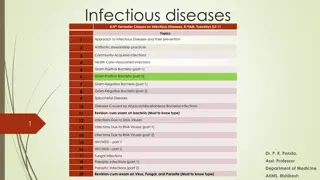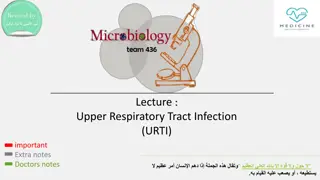
Epidemiological Determinants of C. diphtheriae Infection
Explore the epidemiological determinants of C. diphtheriae infection, including agent factors, infective materials, host factors, mode of transmission, and more. Learn about the source of infection, period of infectivity, immunity, and environmental factors influencing the spread of this gram-positive bacterium. Discover how the disease is transmitted and the importance of herd immunity in preventing epidemics.
Download Presentation

Please find below an Image/Link to download the presentation.
The content on the website is provided AS IS for your information and personal use only. It may not be sold, licensed, or shared on other websites without obtaining consent from the author. If you encounter any issues during the download, it is possible that the publisher has removed the file from their server.
You are allowed to download the files provided on this website for personal or commercial use, subject to the condition that they are used lawfully. All files are the property of their respective owners.
The content on the website is provided AS IS for your information and personal use only. It may not be sold, licensed, or shared on other websites without obtaining consent from the author.
E N D
Presentation Transcript
EPIDEMIOLOGICAL DETERMINANTS AGENT FACTORS AGENT : C. diptheriae (gram positive, non-motile) 4 strains : gravis, mitis, belfanti, intermedius non-toxigenic strain may become toxigenic when exposed to beta-phage. SOURCE OF INFECTION : may be a case or carrier Case : clinical or subclinical Carrier : temporary or chronic . Do not suffer from the disease or show symptoms. Immunization does not prevent carrier state.
INFECTIVE MATERIAL : Nasopharyngeal secretions, discharges from skin lesions, Contaminated fomites and infected dust. PERIOD OF INFECTIVITY : 14 28 days from onset of disease. Carrier can remain infective for longer.
HOST FACTORS AGE : 1-5 years SEX : Both sexes are affected IMMUNITY :Infants borne to immune mothers are immune during first few weeks or months of life. 70% children above 3 years and most children above 5 years are immune . Herd immunity of 70% is required to prevent epidemic spread. ENVIRONMENTAL FACTORS : Occur in all seasons but winter is preferred
MODE OF TRANSMISSION : Disease spreads by droplet infection. Direct transmission from infected cutaneous lesions or from objects contaminated by nasopharyngeal secretions. http://t2.gstatic.com/images?q=tbn:ANd9GcTuO39ttux1zn87jMfZcEQxn8EDV0JOUqgZgAnZtC2wh-mKzA1pLoZoK9Cm










